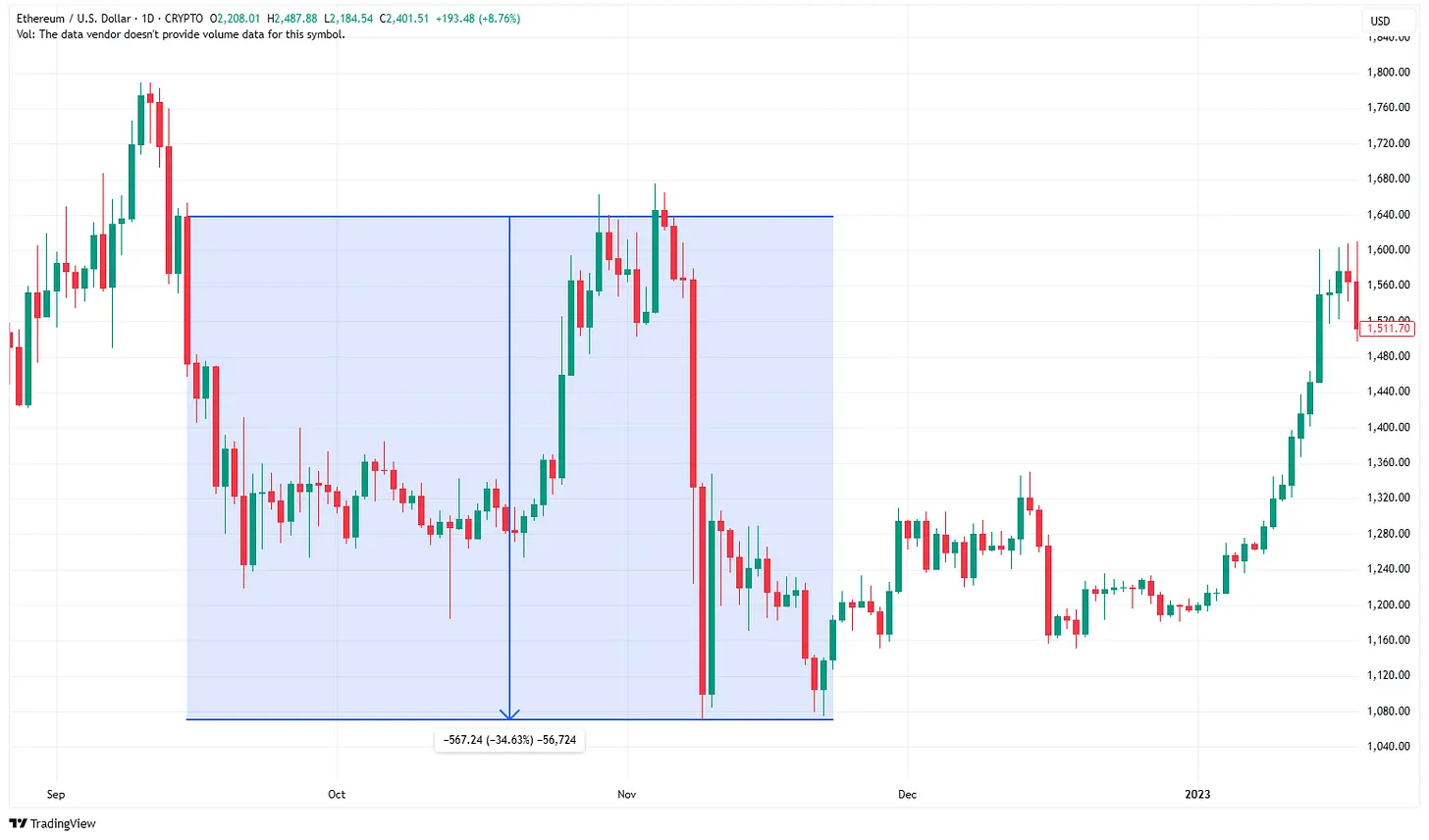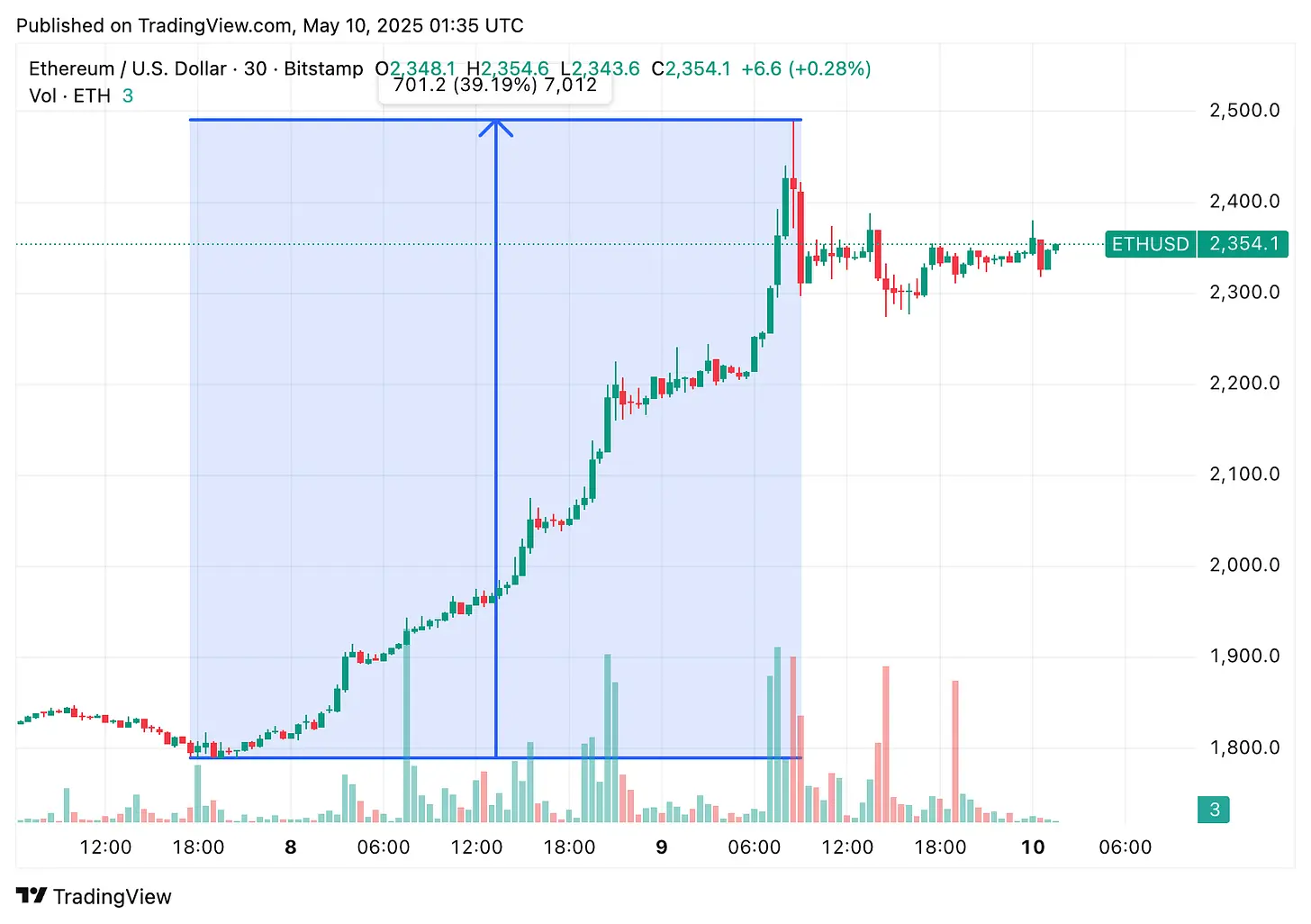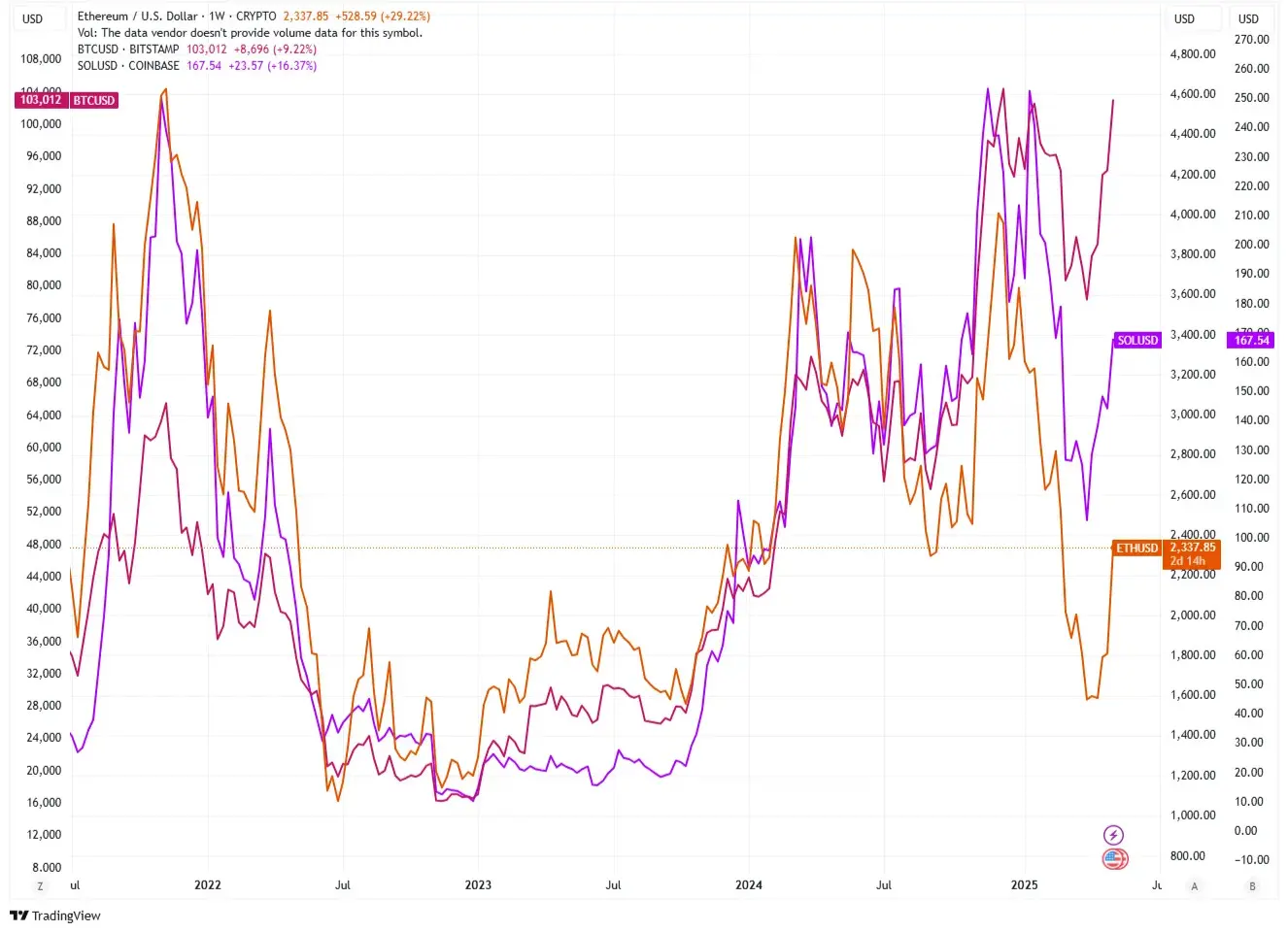ETH posted its strongest weekly performance since 2021 following last Wednesday’s Pectra upgrade.
Original title: “Can Pectra, UX and Team Shuffle Revive ETH?”
Compiled & edited by Patti, ChainCatcher
"One of the most outstanding qualities of Bitcoin is that its protocol is so elegantly designed," said Vitalik Buterin, the founder of Ethereum, the second largest cryptocurrency, when talking about Bitcoin, the first largest cryptocurrency.
The timing of these remarks coincides with the identity crisis that Ethereum is facing.
Vitalik wrote these words a week ago in his blog post “Simplifying the L1”, and three days later, Ethereum developers deployed the most complex upgrade to date to the blockchain.
On the one hand, ETH had its strongest weekly performance since 2021 following Wednesday’s Pectra upgrade. On the other hand, its co-founders want to rebuild the network with a simpler architecture.
Is this the beginning of a renaissance for Ethereum, or just another false dawn for a network that has stagnated for years while its competitors continue to set new highs?
In this article, we’ll explore what’s happening with Ethereum, why these changes matter, and whether these rapid developments can help Ethereum escape its multi-year slump.
Pectra Upgrade: A Key Battle in Ethereum’s Revival Attempt
The success or failure of Ethereum’s revival attempt will largely depend on its recent upgrade.
On May 7, 2024, the pectra upgrade, the most ambitious code change since The Merge (September 2022), went live. This upgrade makes wallets smarter, validators more efficient, and Layer 2 fees lower.
The upgrade, which took more than a month longer than originally planned, changed the way Ethereum works. The core content of the upgrade, Ethereum Improvement Proposal (EIP)-7702, gave ordinary wallets smart contract capabilities.
This seemingly technical change actually reshapes the user's basic experience.
“Ethereum is really starting to feel like the modern web right now,” Binji, an anonymous Optimism contributor, wrote on the X platform, adding that the Pectra upgrade reduces the number of clicks users need to “get what they want to do.”
In short, this upgrade brings the following conveniences to users:
- Users can now bundle multiple actions together for execution, without having to approve each step of the transaction one by one.
- Users can pay transaction fees in stablecoins instead of using Ethereum (ETH) for every transaction.
Dapps can even pay gas fees for users, implementing a “freemium” model where users can interact with them without holding any ETH.
For validators, EIP-7251 significantly increases the staking limit from 32 ETH to 2048 ETH. This means lower operating costs, which is especially beneficial for institutional stakers.
Layer 2 also benefits from this.
EIP-7691 doubles the blob space per block, which helps keep Layer 2 transaction fees low as demand increases. The upgrade comes at a perfect time — Coinbase’s Base Chain developer Jesse Pollak previously warned that demand for Layer 2 will grow “10 to 20 times” by 2025.
So, can these technological improvements translate into a recovery in market confidence?
Historically, Ethereum upgrades are often accompanied by a situation where “all good news comes out bad news.” After the 2022 “merge” upgrade was completed, the price of ETH fell by more than 30%.

@TradingView
However, this time things may be different because the code change is accompanied by a shift in narrative and leadership.
The result? Within 40 hours of the Pectra upgrade going live, the price of ETH surged by about 40%.

@TradingView
V God calls for reshaping Ethereum user experience
Three days before the official launch of the Pectra upgrade, Vitalik Buterin published perhaps his most important visionary article in years, “Simplifying the L1.”
The core message he conveyed in the article was that Ethereum must become "close to as simple as Bitcoin" within five years.
Over the years, Ethereum has added complexity to address various technical challenges, and now the Ethereum co-founder hopes to remove these complexities to ensure the long-term viability and resilience of the network.
In his vision, he noted that even high school students can understand Bitcoin's code. In contrast, Ethereum has become increasingly complex, limiting the range of people who can effectively contribute to it.
Vitalik’s plan includes three radical proposals:
- Replace the Ethereum Virtual Machine (EVM) with the RISC-V architecture. The RISC-V architecture is simpler and more efficient, and is expected to bring "hundred-fold performance improvement."
- Simplify Ethereum's consensus mechanism through "3-Slot-Finality" and abandon complex systems such as epochs and validator shuffling.
- From data encoding to tree structure, the protocols of the entire technology stack are standardized.
Ethereum Foundation Leadership Reshuffle
In February of this year, Aya Miyaguchi, executive director of the Ethereum Foundation, announced that she would move to the newly created position of "Chairman", a change that put an end to months of community dissatisfaction with the leadership and direction of the Foundation.
Previously, critics have increasingly questioned whether the foundation's approach, which puts the pursuit of ideological purity above competitive position in an increasingly competitive market environment, can still meet the development needs of Ethereum.
The resulting reorganization was formally finalized in late April, marking a major governance change in the history of the Ethereum Foundation.

@Ethereum
The foundation’s new leadership quickly identified priorities: expanding Ethereum mainnet capacity, improving Layer 2 rollups, and enhancing user experience.
“We understand the need to accelerate the journey of developers, founders, institutions, and others to build on and adopt Ethereum,” the two co-directors wrote in a public statement.
For years, the foundation has maintained what critics call a “neutral” stance on ecosystem development, avoiding any involvement in activities that appear to be marketing or competitive positioning.
In an interview with Bankless, newly appointed co-director Stańczak said that improving communication is now a priority for the foundation and that "clear messaging is also part of marketing."
This simple statement is a sea change compared to the foundation’s previous reluctance to even acknowledge that marketing is a legitimate function.
Challenges remain
Despite these promising developments, Ethereum still faces significant headwinds.
Currently, Ethereum ETH is trading at around $2,200, less than half of its all-time high of $4,878 set in November 2021. While Bitcoin and Solana have both broken their previous records in 2025, Ethereum is still hovering at a low level.

@TradingView
In March of this year, affected by the market turmoil caused by Trump's tariff policy, ETH fell more than other mainstream cryptocurrencies, and its price briefly fell below $1,600, the first low point for the currency in a year and a half.
Critics point out that there are fundamental problems with Ethereum's economic model.
The paradox of Layer 2: The successful expansion of Layer 2 means that the transaction volume on the main network will decrease, which will in turn lead to a decrease in ETH's transaction fee income.
Inefficient staking: Before the Pectra upgrade, institutional stakers were forced to operate multiple validation nodes due to restrictions on staking rules, which increased costs and reduced returns.
Technical debt accumulation: Ethereum’s complexity slows down innovation and raises the barrier to contribution.
In addition, competition is becoming increasingly fierce.
In February and April of this year, Solan’s DEX trading volume exceeded that of Ethereum. Even in the field of institutional investment, Bitcoin ETFs account for the majority of investment inflows, while Ethereum-related products have a relatively lukewarm market acceptance.
The leadership crisis in March exacerbated these problems.
In this context, it is not difficult to understand why the Ethereum Foundation, Vitalik Buterin, and core developers are now taking active actions on many fronts. After all, maintaining the status quo is no longer sustainable.
So, can these changes reverse the challenges Ethereum has accumulated over the years?
Ethereum Change Calibration
Ethereum’s current transformation is not limited to individual upgrade initiatives, but a recalibration of its overall development path.
As this series of changes progressed, Ethereum finally realized that superior technical capabilities alone were not enough to gain a long-term foothold in the world of cryptocurrency.
The key is the timing of the changes. These changes come after years of market share loss and poor price performance for Ethereum. The 40% surge in ETH prices following the Pectra upgrade shows that investor interest in Ethereum remains strong. However, Ethereum faces a tough competition from projects that built simplicity into their designs from the beginning, rather than retrofitting them later.
The Ethereum Foundation’s move to bring technical experts into management positions and acknowledge the importance of marketing efforts suggests it is beginning to address the cultural inertia that has hindered its competitiveness.
The improvements made by the Pectra upgrade in the validator economic model and L2 expansion will bring positive benefits in the short term. In the long run, whether the five-year RISC-V architecture vision proposed by Vitalik can continue to focus will be a major challenge facing Ethereum. After all, in the past development of Ethereum, it was often difficult to stay focused due to many conflicting priority tasks.
The upcoming next upgrade, Fusaka, will be a key indicator of Ethereum’s strategic transformation. If this upgrade prioritizes mainnet improvements over second-layer network infrastructure, it will confirm that Ethereum’s strategic shift is real and lasting, rather than a temporary move.
The next 12 months will reveal whether these changes are a renaissance for Ethereum or simply a slow adaptation to market realities. For investors, the continued effectiveness of the leadership and the pace of development will be more important than any single technical milestone in determining the network’s ability to stay on track in its new direction.
If Ethereum can complete this transformation while adhering to its core values, its vision of a “world ledger” could reposition ETH as a cornerstone asset for the next generation of the global financial system, with a value far exceeding the current price of $2,200.














